#ja 37 viggen
Explore tagged Tumblr posts
Text

Saab 37 Viggen 🇸🇪
@Kalla_kridget via X
40 notes
·
View notes
Text

Fanart of SkyAero's Viggen OC!
21 notes
·
View notes
Photo

Old Cold Warrior [JA-37]
139 notes
·
View notes
Text
Pictured is an AJS-37 Viggen ("Thunderbolt"), formerly a attack & reconnaissance fighter variant of the JA-37 air superiority fighter now in use by a civilian pilot as this photo was taken after its decommissioning. I couldn't find the owner of the aircraft, but still a wonderful find by the photographer. Want more information on this lovely beast of a jet? Learn more on its production here by Sideprojects! Want to see her up close & personal? Look no further then this lovely video by JPR Photo & Video here! Please consider helping the American Military History Museum in preserving history!

#military#aircraft#civilian aircraft#Flygvapnet#Svenska flygvapnet#sr 71 blackbird#blackbird#sr71#sr 71#ja-37#viggen#fighter jet#thor
182 notes
·
View notes
Text
Aeroseum and Sweden's Jet Fighters
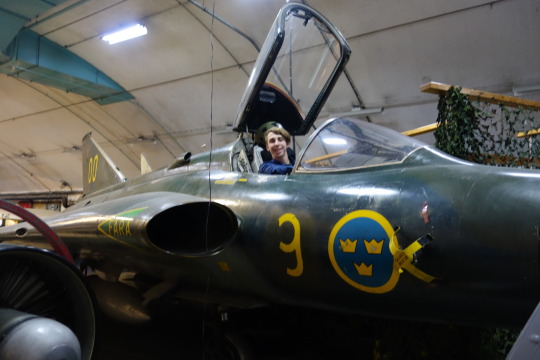
Swedish jet fighters have historically and currently been some of the best fighters in the world. In the Aeroseum(Air Museum), each jet fighter Sweden has developed since their invention.
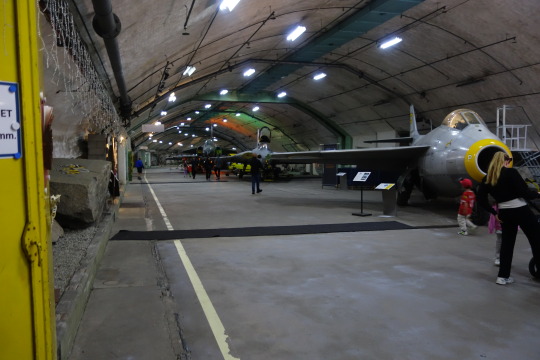
What is just as amazing as the jets is this underground bunker all these planes are stored in. In 1955 they built this bunker so a squadron of planes(40 personnel and 15 Aircraft) would be able to withstand a nuclear blast.
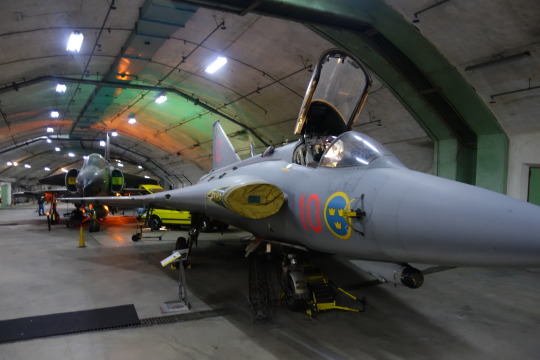
Here's the J35 Draken(Dragon), it's the plane I'm on sitting on in the first picture. Probably the sleekest jet plane I've ever seen and a contender for my favorite jet.

Here's the 37 Viggen, it's the next jet to enter service. While it was built to perform multiple rolls, it was mostly used for maritime reconnaissance. Under it's right wing there is a camera mounted to it.
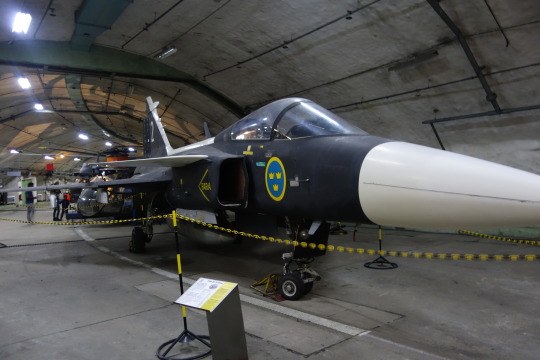
Now this is one mean jet. Introducing the SAAN JAS 39 Grippen. An amazing fighter which was designed, sourced, and built entirely within Sweden.
I'll wrap up this post with a couple more pictures of the Drakken and some other helicopters they had on display.
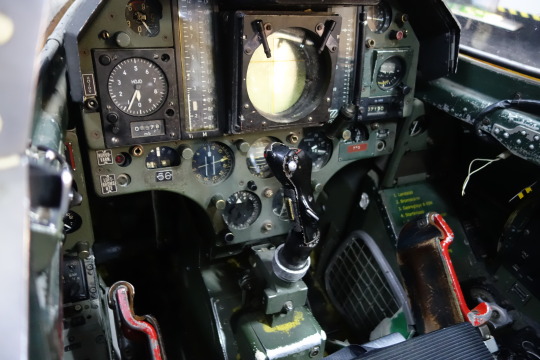

You'll recognize this helicopter from any Vietnam War movie. Sweden procured many of these from the US for search and rescue.
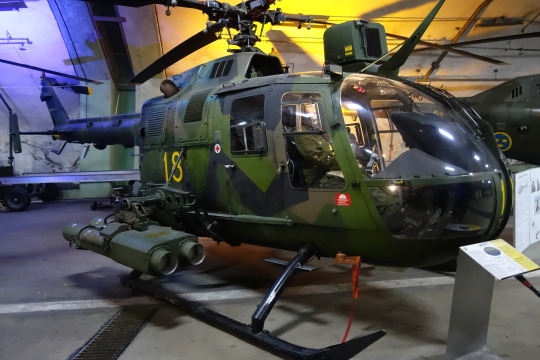
Here is the HKP9. An anti-tank helicopter that can perform a loop.
With this post I am caught up for the moment, tomorrow we'll end up in Jönköping. There should be some really cool and old buildings there!
6 notes
·
View notes
Text

Des avions multirôle Saab JA 37 Viggen de la Svenska flygvapnet (Force aérienne suédoise).
0 notes
Text
FLIGHTLINE: 191- SAAB 37 VIGGEN ("BOLT" OR "TUFTED DUCK")

-A SAAB 37 Viggen in the '70s and '80s era splinter camouflage. | Photo: Swedish Air Force
FLIGHTLINE: 191- SAAB 37 VIGGEN ("BOLT" OR "TUFTED DUCK")
Designed to replace older fighters and attack aircraft in the Swedish Air Force, the Viggen served from the early 70s into the early 2000s.
Development of the Viggen began almost before the planes it was intended to replace, the SAAB 32 Lansen and 35 Draken, took their maiden flights, with the Swedish Air Force beginning work on requirements in 1955. Included were integration into the STRIL-60 electronic air defense system, supersonic speed at low level and Mach 2 performance at altitude, and the ability to land and take off from short, rough fields or even stretches of highway. The latter was further codified in Bas 60, a system of dispersal bases and alternate runways developed by the Swedish Air Force starting in 1958. In the event of war, individual squadrons would be dispersed to krigsflygbaser ("wartime air bases") which had been established ahead of time. Additionally, civilian air ports and specially built sections of the national highway system could also be used as alternatives. As a result, the new aircraft would need to be able to land and take off in 500 meters or less, and further requirements included a modest landing speed at low angles of attack in order to avoid damaging ad hoc runways.
SAAB began design work on a new aircraft between 1952 and 1957, examining and discarding over 100 concepts along the way. Aircraft with one or two engines, tailless delta wings, double deltas, canard designs, and VTOL aircraft incorporating lift jets were all conceived, but by 1963 the new plane, officially titled Aircraft System 37, had taken the form of a single engined aircraft with a double-delta wing mounted low and to the stern, with a large canard foreplane mounted high on the intakes. This configuration had been proven to give the best balance of performance at low and high altitude as well as the needed STOL capability and maneuverability expected of a front-line strike fighter. A defense treaty signed between Sweden and the United States in 1960 allowed access to US research and technology, which resulted in SAAB selecting a license built P&W turbofan to power the System 37. The following year, construction of the first prototype of what became the Viggen began.
DESIGN AND SPECIFICATIONS

-Orthograph of the J 37 Viggen. | Illustration: Kaboldy
The SAAB 37 was roughly the same size as the J 35 Draken, being 16.4m long, with a wingspan of 10.6m, and a height of 5.9m. Empty weight was 9,500kg, while max TO weight varied from 16,400kg to 17,000kg depending on the variant. Maximum speed was Mach 2.1 (2,231 kph) at 11,000 meters, while maximum altitude was 18,000 meters. Six fuel tanks within the aircraft provided a capacity of 5,000 liters of fuel, giving the Viggen a combat radius of 1,000km and a ferry range of 1,800km, while an auxiliary drop tank of 1,500l could also be added to further increase the range. Power was provided by a Volvo RM8A turbofan, a modified and license-built version of the P&W JT8D originally designed for the Boeing 727 and 737. Volvo modified the P&W engine design, with more robust materials going into the manufacture to withstand sustained flight at Mach 2, as well as the addition of an afterburner and thrust reverser, making it the first turbofan so equipped. The RM8A had a dry thrust of 65.6kN and with AB this increased to 115.6kN. As the 37 was designed to be both mechanically simple and easy to maintain, the inlets were D-shaped and without adjustable geometry ramps as on contemporary fighters like the F-4, instead only simple boundary layer splitter plates were incorporated. The thrust-reverser could be preset to engage once the nose gear strut compressed, an innovative feature. Electrical power was provided through a 60kVA generator, and in emergencies a ram-air turbine capable of generating 6kVA was automatically deployed.
The 37's airframe was composed of an aluminum honeycomb structure; a ring aft of the engine was fabricated from titanium for heat-resistance. In order to pull the Viggen into smaller hangars and hardened shelters, the vertical stabilizer cold be folded down via an actuator. The main landing gear, designed for short, rough fields as well as temporary landing strips or stretches of highway, had two wheels arranged in tandem; both wheels were fitted with anti-skid brakes.

-A Viggen being towed from a low-ceilinged hardened shelter. | Photo: Swedish Air Force
The Viggen used a sophisticated suite of avionics, including the Central Kalkylator 37 (CK37, "Central Calculator 37), the first airborne computer to utilize integrated circuits. This digital computer replaced the analogue machines used on earlier aircraft, such as the J 35, which had proven to be difficult to maintain as well as inaccurate in use. On later models of the Viggen, the CK37 was replaced by a license-built copy of the American CD107, which was more powerful. The Viggen used electronics countermeasure equipment developed by Satt Elektronik, including radar warning receivers in the wings and tail, as well as infrared warning receivers. Optionally, an optional Ericsson Erijammer pod and/or SAAB BOZ-100 chaff/flare pod could be added. All told, the SAAB 37 carried 600kg of avionics, a substantial load for single-seat, single engine fighter of the era. Depending on the variant, the Viggen was equipped with either the Ericsson PS 37 or PS 46 radar, both of which operated in the X-band. The PS 37 was capable of air-to-ground and air-to-air telemetry, search, track, terrain-avoidance and cartography, while the more advanced PS 46 had a look-down/shoot-down capacity in excess of 50km, and which could track two targets simultaneously.
The cockpit displays of the 37 included traditional "steam gauge" instruments, as well as a HUD and three CRT screen, which were used to display radar imagery, computer-generated maps, as well as flight and weapons information. During the late 1990s, these CRTs were replaced by LCD screens. The right side of the console panel had dedicated controls and indicators for weapons as well as navigation, oxygen, windshield de-fogging, IFF, and lighting. Situated on the left side were controls for the radar, as well as the landing gear handle, radio controls and the cabin pressure indicator.

-Cockpit of a AJSF 37 Viggen. | Photo: Per80
The pilot was seated on a Raketstol 37 ("Rocket chair 37"), designed for low-altitude, high-speed ejections, and was the last Saab-designed seat used. Once triggered, the entire ejection sequence was automated, including separation of the seat from the pilot. Manual triggers were included in case of malfunction. On twin-seat versions, the pilot in the front cockpit can trigger ejection for both seats.
VARIANTS AND WEAPONS
There were five variants of the Viggen, along with several upgrades and service-life extensions. The AJ 37 (Attack Jakt, "Strike Fighter") was the first to enter service, and was an attack variant with a secondary fighter mission. As such, the AJ's seven pylons could carry 7,000kg of stores, including unguided bombs and pods, such as the Bofors M70, for rockets, as well as the Rb04 anti-ship missile and the Rb05 air-to-surface missile (roughly equivalent to the American Bullpup). No cannon was fitted, though one or two pods could be carried, each of which housed a license-built Aden 30mm cannon and 150 rounds of ammunition. Finally, license-built copies of the AIM-9 Sidewinder, known as the Rb24, could be carried for self-defense. The Viggen was also cleared to carry AIM-4 Falcons, known as the Rb28 in Swedish service, but these were in the process of being phased out. The AJ 37's radar was not spec'd for BVR missiles. 109 AJ 37s were produced.
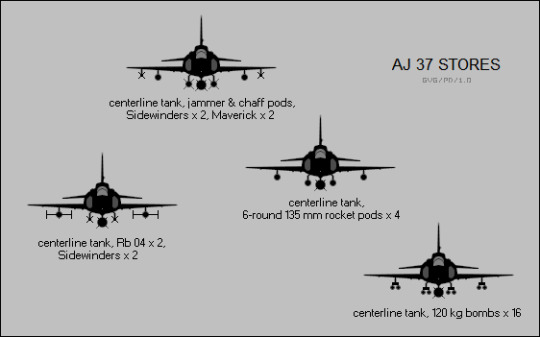
-Schematic of the AJ 37 carrying various loads. | Illustration: airvectors.com
The second model was the SF 37 (Spanings Foto, "Photo Reconnaissance"), which was a modification of the AJ fuselage, with a new nose containing 7 cameras replacing the radar of the strike version. The camera fit included vertical and oblique cameras, as well as an infrared line scanner and data recording unit. Additional pods could be carried under the intakes, including a "Red Barron" night recon unit or a forward-looking long-range optical (LORP) pod. The SF 37 was fitted with radar-warning receivers and countermeasures pods, and could carry self-defense Sidewinders, but the plane lacked a radar, and was not fitted with a gunsight. 28 total SF 37s were completed.

-Orthograph of the SF 37 carrying drop-tanks and camera pods. | Illustration: wp.scn.ru
The third variant was the SH 37 (Spanings Havsoevervakning, "Coastal Surveillance & Reconnaissance") model, which was externally identical to the AJ 37, but the nose contained a new Ericsson PS-371/A radar, which was optimized for maritime surveillance. Like the SF 37, the SH could carry the Red Barron or LORP camera pods, but like the AJ it could also carry the Rb04 anti-ship missile, as well as the other offensive and defensive equipment of the strike version. 27 SH 37 aircraft were built between 1977 and 1979, and Flygvapnet reconnaissance squadrons operated a mix of the SF 37 and SH 37.

-Scale model of an SH 37, armed with Rb04 missiles. | Photo: trickyrich
A two-seat trainer variant was not initially ordered, but the Swedish Air Force reversed itself, and one of the prototypes was completed as a trainer, designated the Sk 37 (Skol, "School"). Based on the AJ 37 airframe, a second cockpit was grafted onto the fuselage, with part of a fuel tank being removed to make space. Two periscopes were added to the instructor's cockpit to improve his view. The tail fin was also modified, with a 10cm extension added to the top of the fin. The trainer version did not have a radar, and although stores could be fitted the the accurate delivery of bombs was somewhat compromised. Interestingly, the Sk retained the fairings for the radar warning gear, though the RWR equipment was not carried. 17 Sk 37s were produced.

-Schematic showing the difference in appearance of the SF and Sk 37 models. | Illustration: airvectors.com
The final production variant was the JA 37 (Jakt, "Fighter"), which saw a longer development as the Flygvapnet felt no rush to retire the J 35 Draken. The JA variant had the same tail extension as the Sk 37, and the fuselage was also stretched 10cm ahead of the wing to accommodate the more powerful RM8B engine, which had a maximum output of 125kN with afterburner. The interceptor had four elevator actuators versus the three present on the other models of Viggen, as the Flygvapnet saw the need for additional maneuverability, and the structure was reinforced to withstand higher stresses. In total, a JA 37 was approximately 400kg heavier than an AJ 37. The fighter carried different avionics than the other Viggen as well, including a PS-46/A radar, with look-down/shoot-down capacity and a range of 48km. The JA 37 also carried a more powerful central computer, the Garrett LD-5 digital air data computer (the same unit carried on the F-14 Tomcat), and one of the first digital flight-control systems. The fighter version was armed with a single Oerlikon KCA 30mm cannon, which had more range and punch than the Aden cannon carried by the AJ 37. The JA 37 had the same seven pylons as other models, with the center hardpoint being the only "wet" (capable of carrying a fuel tank) one. The other pylons could carry up to four Rb24 Sidewinders, as well as two Rb71 Skyflash semi-active radar homing (SARH) missiles. The JA 37 could carry the M70 rocket pods, with the gunsight being used for aiming, but the type was not capable of carrying the other bombs and missiles available to the AJ 37.

-Cutaway drawing of the JA 37, showing internal systems and armaments. | Illustration: SAAB
TESTING AND OPERATIONAL HISTORY
The first Viggen prototype was rolled out of the factory on 24 November 1966, with maiden flight occurring on 8 February 1967, the flight lasting 43 minutes. The second Viggen followed in flight on 21 September '67, and the third on 29 March 1968. By April 1969, all six of the single seat prototypes were flying in different trials for the forthcoming AJ 37 variant. The first aircraft was involved in a fatal accident on 31 May 1968 when the pilot dropped a flight checklist and in reaching for it triggered the ejection seat. Being an early model, it was not a true "zero-zero" seat, and the parachute did not open in time, killing test pilot Lennart Fryoe. The aircraft was repaired and returned to flight shortly thereafter. The fourth prototype was written off after leaving the runway and rolling over during a test on the thrust reverser on 7 May 1969, though the pilot was not seriously injured. That same month, the Viggen made its first public world-wide appearance at the Paris Air Show. On 5 April 1968, a production order for 175 Viggens, a mix of AJ, SF, SH and Sk variants, was placed, with the first production AJ 37 having its maiden flight on 23 February 1971 and delivery to the Flygvapnet in June of that year.

-Five of the Viggen prototypes lined up at the Linköping Testing Center in 1969. | Photo: SAAB

-Viggens under construction at SAAB's factory. In the background are J 35 Drakens for the Danish Air Force. | Photo: SAAB
The Skaraborg Air Force Wing became the first wing to receive the Viggen in 1971, with pilots completing a 450 hour course, first in the SAAB 105 trainer, then the J 32 Lansen before graduating to the Sk 37 tainer and finally the AJ 37. Dedicated simulators were also used, which was later cited as a major factor in pilot's ease of flying the new plane. Still, it took until October 1973 for the Wing to reach full effectiveness; by May 1974 two squadrons were fully operational with the third rapidly approaching complete status. The SH 37 maritime recon variant was officially introduced in 1975, followed in 1977 by the SF photo recon version. In September 1980 the JA 37 fighter model was added, with the Bråvalla Air Force Wing being the first to convert. By the mid-1980s, the Viggen was the Flygvapnet's primary air-defense platform, with the older Lansen relegated to target-tugs and electronics warfare, while the last J 35F wing converted in 1985.

-In order to maximize tactical flexibility, recon missions were often flown by an SH and an SF model, in this photo the SH is in the foreground and armed with a pair of Rb04 while the SF is in the background. | Photo: Flygvapnet

-A fully-loaded JA 37 on a test flight, armed with Sidewinders, Skyflash and cannon. | Photo: Flygvapnet

-Operationally the JA 37 flew in an air-superiority camo scheme of light and dark gray, while the other models sported the tri-color splinter scheme. | Photo: Paul Nann
The Viggen proved to be as easy to maintain as SAAB's engineers intended, with a team of five conscripts under the supervision of one chief mechanic able to keep a plane flying. Refueling and rearming a Viggen could be accomplished in as little as ten minutes, and an engine change could be completed in four hours. The 37 required 9 hours of front-line maintenance and 22 hours of depot level maintenance per flight hour, compared to the J 35, which required a total of 50 hours of maintenance per flight hour.
The effectiveness of the Viggen, as well as the Swedish air defense network as a whole, was demonstrated in the 1980s when, on several occasions. JA 37s tracked USAF SR-71 Blackbirds on their tracks into and out of Soviet airspace. Aided by the predicable course of the Blackbirds, and fed intercept data from ground controllers, the Viggen became the only aircraft acknowledged to have achieved radar lock-on of an SR-71, despite heavy jamming efforts by the American spy planes. These intercepts were kept classified well into the 2000s.
In the early 1990s, an upgrade program was started to modify the AJ, SF and SH variants to a single common configuration, known as the AJS 37. The modified Viggen would be a multi-role aircraft, and numerous upgrades were completed on the aircraft, including the addition of a new data bus and radar, which allowed the AJS 37s to carry AIM-120 AMRAAM missiles (license-built as the Rb99). The upgraded Viggen were also capable of carrying the Rb75, a license-built copy of the AGM-65 Maverick and the Rb15F, an upgrade of the Rb4 anti-ship missile. In all, 115 AJS 37 were completed, with maiden flight of the first converted aircraft occurring on 4 June 1996.
Ten Sk 37s, meanwhile, were converted to electronics warfare trainers between 1998 and 2000, which allowed the planes to act as aggressors during training exercises. This conversion was fairly involved, adding a new data bus, a GPS receiver and comprehensive reworking of the former instructor pilot's cockpit which included flat-panel displays, jammer controls and a separate radio for the electronics warfare officer. The Sk37 E Stoer ("Jammer") was also modified to carry a built-in radar jammer as well as external ECM and flare/chaff pods. The Stoer could also act operationally if the need arose.
The JA 37 fighters also received a series of upgrades in the 90s, including glass cockpit displays, new mission computers and data busses, improved ECM capabilities, a Synthetic Attitude Heading Reference System (SAHRS) to improve navigation, and an upgraded radar that allowed them to also carry the Rb99 AMRAAM missile.

-A JA 37D carrying 3 Rb99 and two Rb24, along with an electronics warfare pod, during an intercept mission. | Photo: Flygvapnet
Despite these upgrades, the Viggens were rapidly approaching the end of their service lives, and in fact had received several extensions due to the protracted development and production of the JAS 39 Grippen that was to take their place. These issues were finally sorted out in the early 2000s, and the final JA 37D was retired from Swedish service in 2005, while the Sk 37E held on until 2007. There were no export operators of the Viggen, despite the proposed 37X variant for Norway in the late 60s, and an attempt in 1975 to sell the 37E model to NATO as a replacement for the F-104 Starfighter.
SURVIVORS
Two Viggen, an AJS and an Sk, are registered to the Swedish Air Force Historic Flight association and are maintained in flight-worthy condition, registered as SE-DXN and SE-DXO respectively. Nearly two dozen Viggen, in part or in whole, are on display in Sweden and across Europe.

-SE-DXN on its inaugural flight after restoration. | Photo: Ragnhild & Neil Crawford

-An AJS 37, in a commemorative red paint scheme, at the Swedish Air Force Museum, Malmslätt. | Photo: Mangan2002
#airplane#airplanes#aircraft#Aviation#avgeek#saab#saab viggen#ja 37 viggen#aj 37 viggen#ajs 37 viggen#saab 37 viggen#swedish air force#sweden#svenska flygvapnet
44 notes
·
View notes
Text

Akktu Stakki - F 21 Luleå


Bild: Anders Nylén
@Kalla_kridget via X

18 notes
·
View notes
Text

Saryn’s older sister. Fourth model of the eight.
Sharon
#planegirl#oc#original#Youka Sharon#Sharon#JA 37 Viggen#JA 37#Viggen#Saab#Saab JA 37 Viggen#Youka#Saryn’n_friends
0 notes
Photo

It’s been a hot minute since I’ve done any viggenposting around here..! Time for a quick intermission from the latest hyperfixation I guess
Redesigned Ragnhild back in Feb so there’s more stuff coming. Just lots of WIPs to piece together as always...
#figured thirty laps around the sun was a good time point to redesign my namesake character around here#the xenomorph look was a happy accident but I'm totally keeping the look#my 13 year old Alien-obsessed self would be flipping out rn haha#JA-37#Ragnhild#Viggen#machine spirit#Jagdviggen#Jet art#the Transformers looks is somewhat intentional tho - she can work as an OC for that setting or as a standalone character as well
111 notes
·
View notes
Text
Eyy. Posting this lad here as well ;0
I'm definitely not great at drawing/designing bots though, still very new.. 😩
But oh well, meet Activator 😩😳

8 notes
·
View notes



